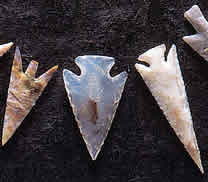
Courtesy of National Park Service
Throughout the Canadian River Valley of the Texas Panhandle are signs and archeological traces of thousands of years of human history. The canyon rims and mesas of this region reveal more than 700 stone quarries where for over 13,000 years prehistoric peoples harvested and used the colorful stone known as Alibates flint. The flint, which is actually agatized dolomite, was quarried to make projectile points, knives, scrapers, and other tools. Alibates Flint Quarries National Monument preserves nearly 1,000 acres of the remains of this precontact American Indian quarrying site.
Alibates flint is an extremely colorful stone with rainbow hues ranging in colors from pale gray and white to pink, maroon, bright red, orange-gold, and purple-blue. The stone has variable patterns including bands of alternating color that give it a striped and marbled pattern. Distinctive for its many colors, the flint comes from a 10-square-mile area around Lake Meredith, Texas but mostly is concentrated on about 60 acres atop a mesa in the heart of the Monument. Prehistoric peoples would come to the red bluffs above the Canadian River to harvest this multi-colored, highly prized stone that could hold a hard edge and that was in high demand along trading routes throughout North America. Projectile points and other tools made of Alibates stone have been found in sites across the Great Plains, the Southwest, as far north as Montana, and as far east as the Mississippi River.
About a foot or more below the surface, prehistoric peoples quarried un-weathered flint by digging it out by hand, with sticks, or with bonetools. More than 700 quarries exist where they quarried this flint. During their peak usage, the quarries were from five to twenty-five feet across and about four to eight feet deep. Centuries of wind and rain have filled them in, and today they appear as round ovals about six or more feet in diameter with depressions in the center. Beyond the shallow quarry pits are the chunks, pieces, and waste piles of this quarrying activity. To view this impressive piece of North American history, visitors can take a ranger guided tour of the site.
For much of the quarry’s history, nomadic peoples gathered in the area and used the flint. Archeologists theorize that the people of the Ice Age Clovis Culture hunted with spears tipped with the colorful Alibates flint points. They used these points to hunt now-extinct large game animals, including the Imperial Mammoth, even before the Great Lakes of North America formed. Eventually, between 1150 and 1450 AD, a group of people identified as the Plains Village Indians, who were ancestors of the Caddo, Pawnee, and Wichita, established permanent communities near the quarry site and along the Canadian River valley.
Plains Village Indians lived here in large permanent villages and smaller, outlying farming and gathering communities. The ruins of these villages reveal complex rock-slab houses, and range from single-unit dwellings to 100 room structures. While they were primarily a farming community, the Plains Village Indians also quarried the flint and traded it for items such as Puebloan pottery, Pacific coast seashells, Minnesota pipestone, and turquoise jewelry. By the end of the 15th century, severe drought and raids from aggressive tribes from the west drove the Plains Village Indians from the Alibates Flint Quarries region.
Visitors to the Alibates Flint Quarries National Monument can take a ranger-guided tour of the quarries, go on a hike, or simply sit and view the surrounding wildlife. The walking tour is a one mile walk up a moderately steep trail. Along the tour, visitors will see the plains of the Texas Panhandle along with the ‘Canadian Breaks,’ a broken landscape formed mostly by water erosion where low laying plateaus mix with mesas, buttes, and large scattered boulders. The striking reds, oranges, yellows, blues, and greens of the Alibates flints will leave a lasting impression about the 13,000-year history of Alibates Flint Quarries National Monument.
Alibates Flint Quarries National Monument, a unit of the National Park System, is located north of Amarillo and south of Fritch, TX off Hwy 136. The Monument offers tours year round by reservation only. Tours leave daily at 10:00 am and 2:00 pm. For more information, visit the National Park Service Alibates Flint Quarries National Monument website or call 806-857-3151.
Last updated: August 8, 2017
